THEME: SCENERY
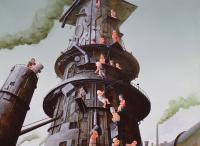 Zhu Zhiwei’s paintings dwell on the incredible scale of China’s industrialization, and the relationship between modern city-dwellers and the man-made environment that they inhabit. In Paradise—Chasing the Wind, factories obscure the horizon. The elongated format and multiple, skewed perspectives of create an intentionally disorienting, fantastical setting. The large central tower seems to be falling apart while it is swarmed by Zhu’s distinctive pink figures. Wearing sunglasses, they climb, dangle and perch on the tower’s nonsensical railings and ledges, creating the impression of an industrial playground. A few characters appear in heroic poses - climbing, carrying objects or helping each other scale the structure. Some sit idly, while others busy themselves pulling pieces off the tower or casting debris downwards. The painting’s lone woman, wearing a qipao (a traditional Chinese dress), dangles her heels, while two men engage in a fistfight down below. On the higher platforms several people. including a man in a red cape, look off into the distance. All appear to be oblivious to rickety state of the tower.
Zhu Zhiwei’s paintings dwell on the incredible scale of China’s industrialization, and the relationship between modern city-dwellers and the man-made environment that they inhabit. In Paradise—Chasing the Wind, factories obscure the horizon. The elongated format and multiple, skewed perspectives of create an intentionally disorienting, fantastical setting. The large central tower seems to be falling apart while it is swarmed by Zhu’s distinctive pink figures. Wearing sunglasses, they climb, dangle and perch on the tower’s nonsensical railings and ledges, creating the impression of an industrial playground. A few characters appear in heroic poses - climbing, carrying objects or helping each other scale the structure. Some sit idly, while others busy themselves pulling pieces off the tower or casting debris downwards. The painting’s lone woman, wearing a qipao (a traditional Chinese dress), dangles her heels, while two men engage in a fistfight down below. On the higher platforms several people. including a man in a red cape, look off into the distance. All appear to be oblivious to rickety state of the tower.
Amidst this flurry of activity, the tower’s purpose remains unclear; the top disappears into a dark, hazy cloud of smoke that drifts across the upper left-hand corner of the composition. The painting’s low vantage point and the strong diagonal lines formed by the tubes on either side of the tower create a disorienting perspective. Viewing the tower from its base, we too can contemplate climbing its dislocated staircases.
Click on the artwork for more information-
$35.00
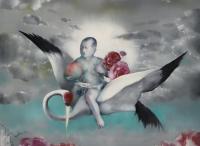 Luo Fahui is part of the generation of artists who studied fine arts shortly after the Cultural Revolution (1966-1976). His oil paintings, which are characterized by surreal, pearly gray compositions, punctuated by bright splashes of crimson and turquoise, address themes of desire, isolation and violence.
Luo Fahui is part of the generation of artists who studied fine arts shortly after the Cultural Revolution (1966-1976). His oil paintings, which are characterized by surreal, pearly gray compositions, punctuated by bright splashes of crimson and turquoise, address themes of desire, isolation and violence.
The title of this work refers to ancient poems of mystical excursion, in which a Daoist master is carried off to the realm of the Immortals. These stories were sometimes fantasies of poets who dreamt of escaping conventional society. In Chinese mythology, the Immortals’ preferred mode of transportation was a fantastical red-crowned crane; mortals who achieved immortality were similarly carried off by one of these creatures. The Immortals prized rare magical peaches, which conferred 1000 years of life on those who consumed them.
In Mystical Journey, the artist has added a slew of roses, which in Luo’s work are frequently associated with desire and lust. The Daoist master has been replaced with a large fleshy boy, possibly the artist’s alter-ego. The crane hovers indecisively between an inviting bed of lush blossoms below and the glowing heavens above. The child bears a peach of immortality in one arm and more roses in the other. It appears that some difficult choices will have to be made if the journey to transcendence is to be completed.
Click on the artwork for more information-
$35.00
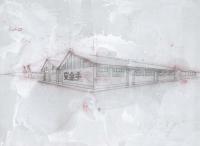 Chen Jiao's November 7th is named after a date, but features an industrial building, sketched lightly against a square grid. More than the building itself, its form stands out against the blank background, with perspective points and the foreground's boundary clearly visible. Against the front building's side, a slogan is available: “safe production,” painted in bold red characters. The final two characters are each drawn backwards, giving a clue that this is image is not actually meant to be a precise rendering of an actual structure. The markings of light color washes are visible in the background, and the work is dotted with Chen's calculations, leaving building measurements and calculations visible. But Chen is no architect. Trained in oil paiting at the Sichuan Fine Art Institute, Chen leaves the calculations visible as a means of voicing the utility and design that goes into the sketch, asking which meanings remain when the building is described in only its signs.
Chen Jiao's November 7th is named after a date, but features an industrial building, sketched lightly against a square grid. More than the building itself, its form stands out against the blank background, with perspective points and the foreground's boundary clearly visible. Against the front building's side, a slogan is available: “safe production,” painted in bold red characters. The final two characters are each drawn backwards, giving a clue that this is image is not actually meant to be a precise rendering of an actual structure. The markings of light color washes are visible in the background, and the work is dotted with Chen's calculations, leaving building measurements and calculations visible. But Chen is no architect. Trained in oil paiting at the Sichuan Fine Art Institute, Chen leaves the calculations visible as a means of voicing the utility and design that goes into the sketch, asking which meanings remain when the building is described in only its signs.
Click on the artwork for more information-
$35.00
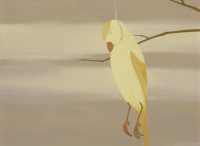 Disquieting in both its graphic content and perverse visual appeal, this work provides the conflicting experience of drawing you in while turning your stomach. A skillfully depicted, brightly colored songbird dangles lifelessly from a miniature noose strung on a bare, spindly branch. The backdrop of pale, drab clouds set against a muted sky give the unsettling feeling of either an execution at dawn or a polluted wasteland. The composition and painting style provide a disturbing variation on Northern Song (960-1126) bird-and-flower painting, which traditionally presented lively birds perched on elegant floral branches against a background of plain taupe silk. In Lili's reinterpretation, all the leaves have wilted and fallen away, and the bird has opted to take its own life. Although dramatic, the work is instilled with a sense of peace and surrender.
Disquieting in both its graphic content and perverse visual appeal, this work provides the conflicting experience of drawing you in while turning your stomach. A skillfully depicted, brightly colored songbird dangles lifelessly from a miniature noose strung on a bare, spindly branch. The backdrop of pale, drab clouds set against a muted sky give the unsettling feeling of either an execution at dawn or a polluted wasteland. The composition and painting style provide a disturbing variation on Northern Song (960-1126) bird-and-flower painting, which traditionally presented lively birds perched on elegant floral branches against a background of plain taupe silk. In Lili's reinterpretation, all the leaves have wilted and fallen away, and the bird has opted to take its own life. Although dramatic, the work is instilled with a sense of peace and surrender.
Click on the artwork for more information-
$35.00
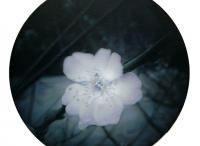 The fresh blossom in A Touch of Plum stands out against a desolate grey background of bare winter branches. While the other portraits Yang Xun's Flowers series all depict a supernatural light shining from the center of their subjects, this early bloomer appears woefully mortal. According to the artist, "The pale pink petals are tender and innocent, but in this desolate scene, seem to have bloomed in vain. This defiant but fragile blossom is bound to inspire hope for an early Spring." Yang’s Flowers series was inspired by Song dynasty flower paintings on round fans. With brilliant light and soft shadow, he uses his subjects to portray multisensory memories of attraction, hope, longing or despair.
The fresh blossom in A Touch of Plum stands out against a desolate grey background of bare winter branches. While the other portraits Yang Xun's Flowers series all depict a supernatural light shining from the center of their subjects, this early bloomer appears woefully mortal. According to the artist, "The pale pink petals are tender and innocent, but in this desolate scene, seem to have bloomed in vain. This defiant but fragile blossom is bound to inspire hope for an early Spring." Yang’s Flowers series was inspired by Song dynasty flower paintings on round fans. With brilliant light and soft shadow, he uses his subjects to portray multisensory memories of attraction, hope, longing or despair.
Click on the artwork for more information-
$35.00








